Xiaoguang Zhu
Feature Calibration enhanced Parameter Synthesis for CLIP-based Class-incremental Learning
Mar 25, 2025Abstract:Class-incremental Learning (CIL) enables models to continuously learn new class knowledge while memorizing previous classes, facilitating their adaptation and evolution in dynamic environments. Traditional CIL methods are mainly based on visual features, which limits their ability to handle complex scenarios. In contrast, Vision-Language Models (VLMs) show promising potential to promote CIL by integrating pretrained knowledge with textual features. However, previous methods make it difficult to overcome catastrophic forgetting while preserving the generalization capabilities of VLMs. To tackle these challenges, we propose Feature Calibration enhanced Parameter Synthesis (FCPS) in this paper. Specifically, our FCPS employs a specific parameter adjustment mechanism to iteratively refine the proportion of original visual features participating in the final class determination, ensuring the model's foundational generalization capabilities. Meanwhile, parameter integration across different tasks achieves a balance between learning new class knowledge and retaining old knowledge. Experimental results on popular benchmarks (e.g., CIFAR100 and ImageNet100) validate the superiority of the proposed method.
Adaptive Weighted Parameter Fusion with CLIP for Class-Incremental Learning
Mar 25, 2025Abstract:Class-incremental Learning (CIL) enables the model to incrementally absorb knowledge from new classes and build a generic classifier across all previously encountered classes. When the model optimizes with new classes, the knowledge of previous classes is inevitably erased, leading to catastrophic forgetting. Addressing this challenge requires making a trade-off between retaining old knowledge and accommodating new information. However, this balancing process often requires sacrificing some information, which can lead to a partial loss in the model's ability to discriminate between classes. To tackle this issue, we design the adaptive weighted parameter fusion with Contrastive Language-Image Pre-training (CLIP), which not only takes into account the variability of the data distribution of different tasks, but also retains all the effective information of the parameter matrix to the greatest extent. In addition, we introduce a balance factor that can balance the data distribution alignment and distinguishability of adjacent tasks. Experimental results on several traditional benchmarks validate the superiority of the proposed method.
CRCL: Causal Representation Consistency Learning for Anomaly Detection in Surveillance Videos
Mar 24, 2025Abstract:Video Anomaly Detection (VAD) remains a fundamental yet formidable task in the video understanding community, with promising applications in areas such as information forensics and public safety protection. Due to the rarity and diversity of anomalies, existing methods only use easily collected regular events to model the inherent normality of normal spatial-temporal patterns in an unsupervised manner. Previous studies have shown that existing unsupervised VAD models are incapable of label-independent data offsets (e.g., scene changes) in real-world scenarios and may fail to respond to light anomalies due to the overgeneralization of deep neural networks. Inspired by causality learning, we argue that there exist causal factors that can adequately generalize the prototypical patterns of regular events and present significant deviations when anomalous instances occur. In this regard, we propose Causal Representation Consistency Learning (CRCL) to implicitly mine potential scene-robust causal variable in unsupervised video normality learning. Specifically, building on the structural causal models, we propose scene-debiasing learning and causality-inspired normality learning to strip away entangled scene bias in deep representations and learn causal video normality, respectively. Extensive experiments on benchmarks validate the superiority of our method over conventional deep representation learning. Moreover, ablation studies and extension validation show that the CRCL can cope with label-independent biases in multi-scene settings and maintain stable performance with only limited training data available.
A Survey on Video Analytics in Cloud-Edge-Terminal Collaborative Systems
Feb 10, 2025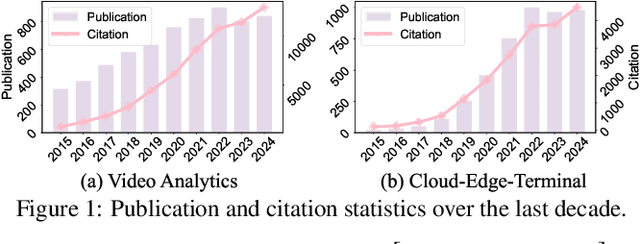
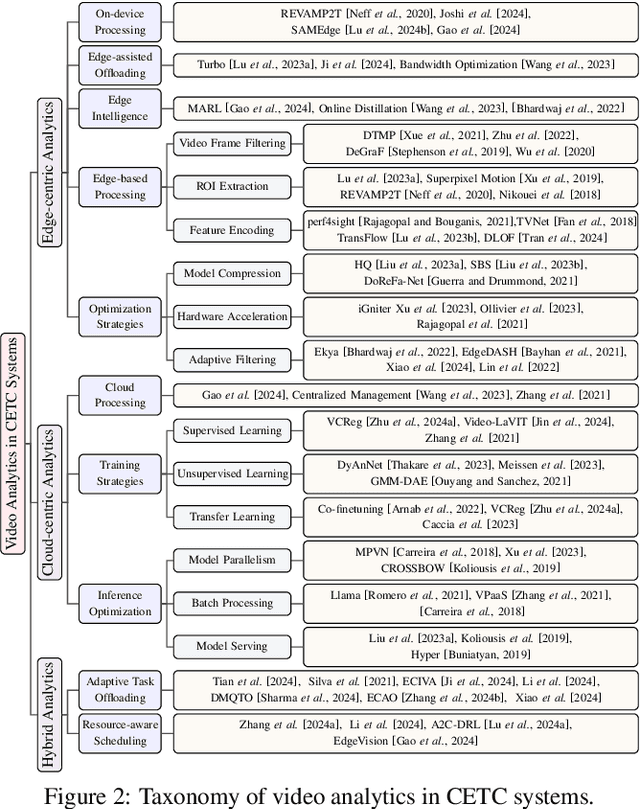
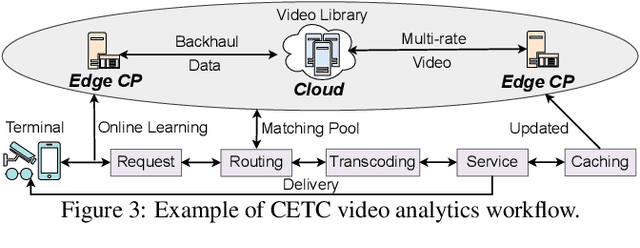
Abstract:The explosive growth of video data has driven the development of distributed video analytics in cloud-edge-terminal collaborative (CETC) systems, enabling efficient video processing, real-time inference, and privacy-preserving analysis. Among multiple advantages, CETC systems can distribute video processing tasks and enable adaptive analytics across cloud, edge, and terminal devices, leading to breakthroughs in video surveillance, autonomous driving, and smart cities. In this survey, we first analyze fundamental architectural components, including hierarchical, distributed, and hybrid frameworks, alongside edge computing platforms and resource management mechanisms. Building upon these foundations, edge-centric approaches emphasize on-device processing, edge-assisted offloading, and edge intelligence, while cloud-centric methods leverage powerful computational capabilities for complex video understanding and model training. Our investigation also covers hybrid video analytics incorporating adaptive task offloading and resource-aware scheduling techniques that optimize performance across the entire system. Beyond conventional approaches, recent advances in large language models and multimodal integration reveal both opportunities and challenges in platform scalability, data protection, and system reliability. Future directions also encompass explainable systems, efficient processing mechanisms, and advanced video analytics, offering valuable insights for researchers and practitioners in this dynamic field.
Privacy-Preserving Video Anomaly Detection: A Survey
Nov 21, 2024



Abstract:Video Anomaly Detection (VAD) aims to automatically analyze spatiotemporal patterns in surveillance videos collected from open spaces to detect anomalous events that may cause harm without physical contact. However, vision-based surveillance systems such as closed-circuit television often capture personally identifiable information. The lack of transparency and interpretability in video transmission and usage raises public concerns about privacy and ethics, limiting the real-world application of VAD. Recently, researchers have focused on privacy concerns in VAD by conducting systematic studies from various perspectives including data, features, and systems, making Privacy-Preserving Video Anomaly Detection (P2VAD) a hotspot in the AI community. However, current research in P2VAD is fragmented, and prior reviews have mostly focused on methods using RGB sequences, overlooking privacy leakage and appearance bias considerations. To address this gap, this article systematically reviews the progress of P2VAD for the first time, defining its scope and providing an intuitive taxonomy. We outline the basic assumptions, learning frameworks, and optimization objectives of various approaches, analyzing their strengths, weaknesses, and potential correlations. Additionally, we provide open access to research resources such as benchmark datasets and available code. Finally, we discuss key challenges and future opportunities from the perspectives of AI development and P2VAD deployment, aiming to guide future work in the field.
Learning Appearance-motion Normality for Video Anomaly Detection
Jul 27, 2022
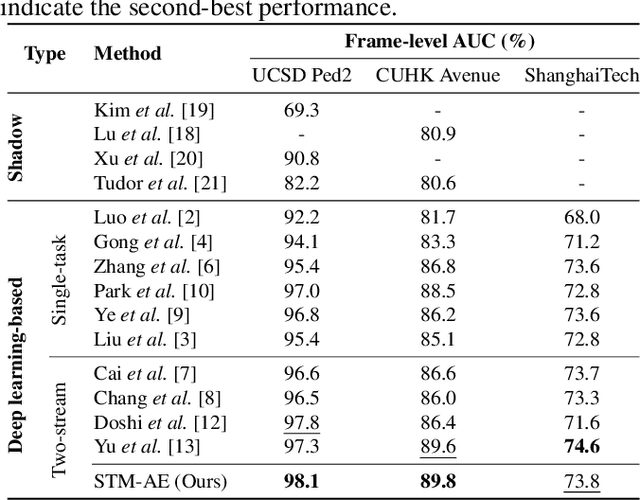
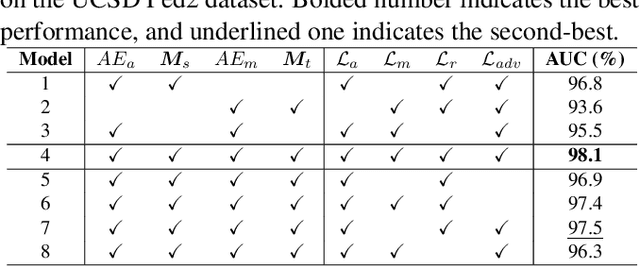
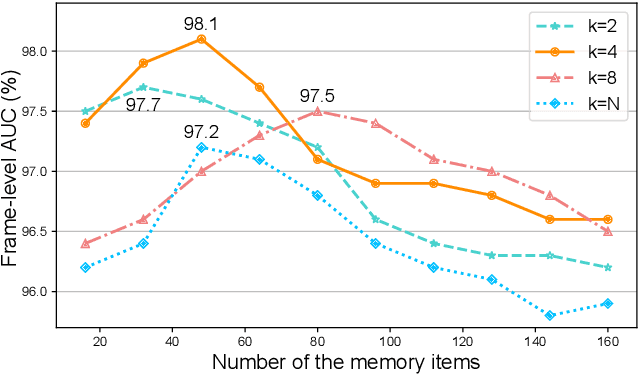
Abstract:Video anomaly detection is a challenging task in the computer vision community. Most single task-based methods do not consider the independence of unique spatial and temporal patterns, while two-stream structures lack the exploration of the correlations. In this paper, we propose spatial-temporal memories augmented two-stream auto-encoder framework, which learns the appearance normality and motion normality independently and explores the correlations via adversarial learning. Specifically, we first design two proxy tasks to train the two-stream structure to extract appearance and motion features in isolation. Then, the prototypical features are recorded in the corresponding spatial and temporal memory pools. Finally, the encoding-decoding network performs adversarial learning with the discriminator to explore the correlations between spatial and temporal patterns. Experimental results show that our framework outperforms the state-of-the-art methods, achieving AUCs of 98.1% and 89.8% on UCSD Ped2 and CUHK Avenue datasets.
Rethinking Saliency Map: An Context-aware Perturbation Method to Explain EEG-based Deep Learning Model
May 30, 2022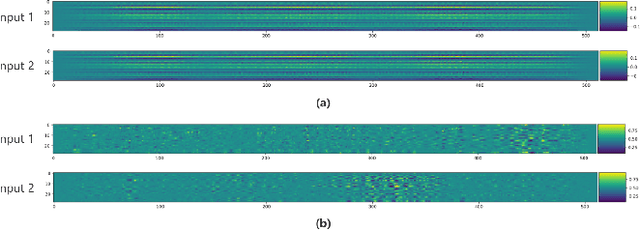



Abstract:Deep learning is widely used to decode the electroencephalogram (EEG) signal. However, there are few attempts to specifically investigate how to explain the EEG-based deep learning models. We conduct a review to summarize the existing works explaining the EEG-based deep learning model. Unfortunately, we find that there is no appropriate method to explain them. Based on the characteristic of EEG data, we suggest a context-aware perturbation method to generate a saliency map from the perspective of the raw EEG signal. Moreover, we also justify that the context information can be used to suppress the artifacts in the EEG-based deep learning model. In practice, some users might want a simple version of the explanation, which only indicates a few features as salient points. To this end, we propose an optional area limitation strategy to restrict the highlighted region. To validate our idea and make a comparison with the other methods, we select three representative EEG-based models to implement experiments on the emotional EEG dataset DEAP. The results of the experiments support the advantages of our method.
Supplementing Missing Visions via Dialog for Scene Graph Generations
Apr 23, 2022



Abstract:Most current AI systems rely on the premise that the input visual data are sufficient to achieve competitive performance in various computer vision tasks. However, the classic task setup rarely considers the challenging, yet common practical situations where the complete visual data may be inaccessible due to various reasons (e.g., restricted view range and occlusions). To this end, we investigate a computer vision task setting with incomplete visual input data. Specifically, we exploit the Scene Graph Generation (SGG) task with various levels of visual data missingness as input. While insufficient visual input intuitively leads to performance drop, we propose to supplement the missing visions via the natural language dialog interactions to better accomplish the task objective. We design a model-agnostic Supplementary Interactive Dialog (SI-Dial) framework that can be jointly learned with most existing models, endowing the current AI systems with the ability of question-answer interactions in natural language. We demonstrate the feasibility of such a task setting with missing visual input and the effectiveness of our proposed dialog module as the supplementary information source through extensive experiments and analysis, by achieving promising performance improvement over multiple baselines.
Skeleton Sequence and RGB Frame Based Multi-Modality Feature Fusion Network for Action Recognition
Feb 23, 2022



Abstract:Action recognition has been a heated topic in computer vision for its wide application in vision systems. Previous approaches achieve improvement by fusing the modalities of the skeleton sequence and RGB video. However, such methods have a dilemma between the accuracy and efficiency for the high complexity of the RGB video network. To solve the problem, we propose a multi-modality feature fusion network to combine the modalities of the skeleton sequence and RGB frame instead of the RGB video, as the key information contained by the combination of skeleton sequence and RGB frame is close to that of the skeleton sequence and RGB video. In this way, the complementary information is retained while the complexity is reduced by a large margin. To better explore the correspondence of the two modalities, a two-stage fusion framework is introduced in the network. In the early fusion stage, we introduce a skeleton attention module that projects the skeleton sequence on the single RGB frame to help the RGB frame focus on the limb movement regions. In the late fusion stage, we propose a cross-attention module to fuse the skeleton feature and the RGB feature by exploiting the correlation. Experiments on two benchmarks NTU RGB+D and SYSU show that the proposed model achieves competitive performance compared with the state-of-the-art methods while reduces the complexity of the network.
 Add to Chrome
Add to Chrome Add to Firefox
Add to Firefox Add to Edge
Add to Edge